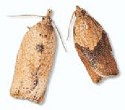Light Brown Apple Moth

Light Brown Apple Moth in California
The U.S. Department of Agriculture (USDA) and the California Department of Food and Agriculture (CDFA) issued press release on March 22, 2007 announcing the confirmation of light brown apple moth (LBAM), Epiphyas postvittana (Walker) (Lepidoptera: Tortricidae), in California. On May 2, the USDA and the Animal and Plant Health Inspection Service (APHIS) implemented a Federal Order to restrict the interstate movement of certain regulated articles, including nursery stock, cut flowers and greenery, from several counties in California and the entire state of Hawaii to prevent the spreading of the LBAM. On May 30, a total of 3,597 LBAM were detected in Alameda, Contra Costa, Marin, Monterey, Napa, San Francisco, San Mateo, Santa Clara, and Santa Cruz Counties.
The LBAM is native to Australia and was established in Tasmania, New Zealand, England, and Hawaii. Its discovery in California is a new record in the mainland of North America. The larvae of the moth feed on more than 250 plants, including fruit crops, vegetables, ornamentals, and broad-leaf weeds. The LBAM belongs to the leaf-rolling moth family (Tortricidae). The greenish larvae construct silken shelters by rolling or webbing the leaves together. The fully-grown larva is 1/3 to 2/3 inch in length and will wriggle vigorously backwards when disturbed. The moth has three to four generations per year in Australia, depending on the latitude.
For updated information of the LBAM in California, the Federal Domestic Quarantine Order on May 2, the biology of the moth, the hosts of the pest, and photos of different life stages, please check the Related Websites. If larvae of LBAM are suspected to be on your plants, please contact the local Agricultural Commissioner, the local University of California Cooperative Extension, or Shimat Joseph (831-759-7359) at the University of California Cooperative Extension, Monterey County.
